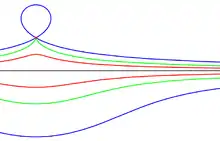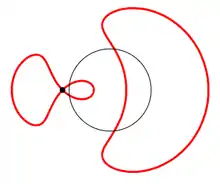conchoid
English

Conchoid of Nicomedes (conchoid of a straight line) for various values of the set distance. The black line is the reference curve (C in the definition), and the red dot is the fixed point (P).

A conchoid of circle
Etymology
From Latin concha (“mussel”) (from Ancient Greek κόγχη (kónkhē)) + -oid or directly from Ancient Greek κογχοειδής (konkhoeidḗs), referring to the curved outline of a mussel shell or anything in this form.
Noun
conchoid (plural conchoids)
- (mathematics, geometry) Any of a family of curves defined as the locus of points p, such that each p is on a line that passes through a given fixed point P and intersects a given curve, C, and the distance from p to the point of intersection with C is a specified constant (note that for nontrivial cases two such points p satisfy the criteria, and the resultant curve has two parts).
- The conchoid of a circle with respect to a point on the circle is a cardioid if the fixed distance is equal to the diameter of the circle.
- The Conchoid of Nicomedes is the conchoid of a straight line with respect to a point not on the line.
- 1815, Charles Hutton, Pappus, entry in A Philosophical and Mathematical Dictionary, Volume 2, page 147,
- He next treats of the properties of the Conchoid, which Nicomedes invented for doubling the cube; applying it to the solution of certain problems concerning Inclinations, with the finding of two mean proportionals, and cubes in any proportion whatever.
- 1982, J. Lee Kavanau, Curves and Symmetry, volume 1, page 3:
- The classical conchoid construction is a non-orthogonal polar-curvilinear construction in which equal distances along a line are marked off from its point of intersection with a curve for various positions of the line as it rotates about a point.
- (geology) A conchoidal fracture in rock.
- 1948, Tennessee Valley Authority, The Hiwassee Valley Projects, Technical Report, Issue 5, Volume 2, page 359,
- Conchoids of sound rock, from a few feet to 20 or more feet in diameter, entirely surrounded by comparatively thin layers of weathered material, were frequently encountered, sometimes in adjacent series.
- 1948, Tennessee Valley Authority, The Hiwassee Valley Projects, Technical Report, Issue 5, Volume 2, page 359,
Usage notes
The fixed point (P) of the construction may be referred to as the focus of the conchoid; it may also be defined as the origin (of a Cartesian coordinate system) or the pole (if polar coordinates are used), and potentially referred to accordingly. The curve C is an example of a directrix.
Derived terms
- conchoid of de Sluze (strictly a cissoid)
- conchoid of Dürer (not actually a conchoid)
- conchoid of Nicomedes
Related terms
Translations
any of a certain family of curves
|
This article is issued from Wiktionary. The text is licensed under Creative Commons - Attribution - Sharealike. Additional terms may apply for the media files.